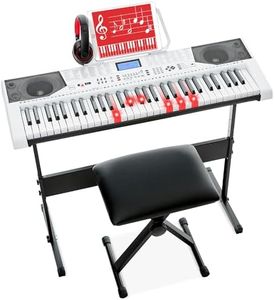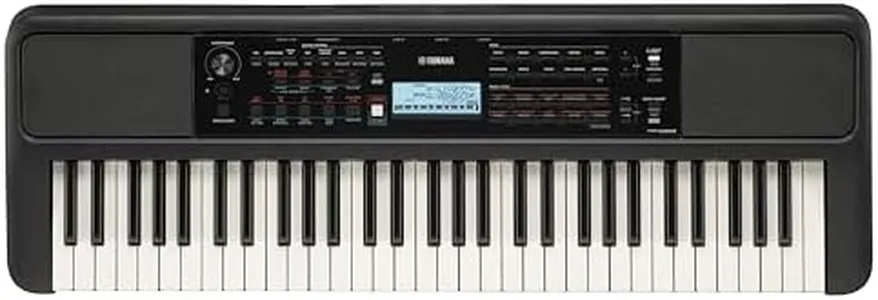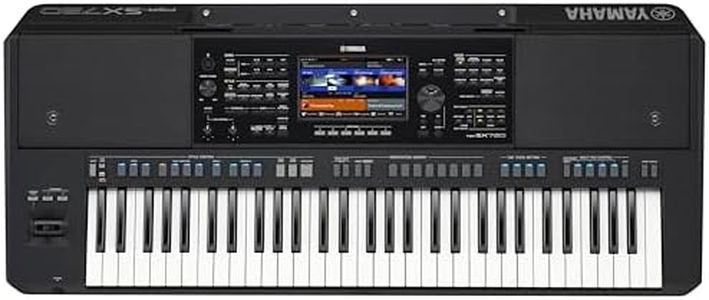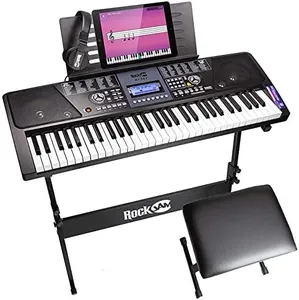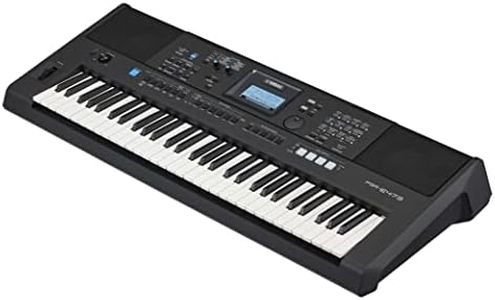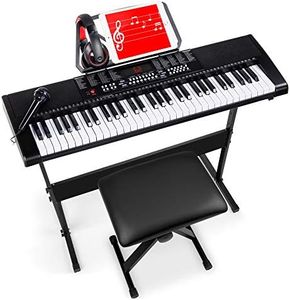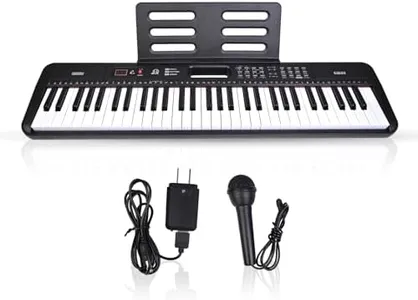10 Best 61 Key Piano Keyboard 2026 in the United States
Our technology thoroughly searches through the online shopping world, reviewing hundreds of sites. We then process and analyze this information, updating in real-time to bring you the latest top-rated products. This way, you always get the best and most current options available.

Our Top Picks
Winner
Yamaha 61 Touch Sensitive Keys Portable Keyboard for Beginners with Music Rest, Power Adapter PSR-E383
Most important from
692 reviews
The Yamaha PSR-E383 is a solid choice for beginners and intermediate players looking for a portable 61-key keyboard. It features touch-sensitive keys which help users develop proper playing technique by responding to how hard you press, making the playing experience more expressive and realistic. Yamaha’s Touch Tutor and Keys to Success functions offer step-by-step guidance and volume control based on touch, providing valuable learning tools not common in many beginner keyboards. The Smart Chord feature allows easy chord playing, ideal for those still getting comfortable with hand positioning.
Sound quality is good for its category, with a variety of voices and rhythms built-in, suitable for experimenting with different styles. The keyboard is fairly lightweight at about 9.7 pounds and compact, making it easy to carry around, though it is not the smallest option on the market.
Connectivity includes a standard 6.35mm headphone jack for private practice, and it can run on batteries or a power adapter, which adds flexibility for use on the go. It lacks modern USB or Bluetooth connections found in some competitors, which might limit integration with computers or apps. This keyboard balances ease of use, touch sensitivity, and learning tools well, making it ideal for teens and beginners who want a portable keyboard with quality sound and helpful features. Advanced players might find the connectivity and polyphony options somewhat limited.
Most important from
692 reviews
Yamaha 61-Key Arranger Keyboard, Multiple Styles and Voices, Assignable Live Control Knobs PSRSX720
Most important from
218 reviews
The Yamaha PSR-SX720 is a 61-key arranger keyboard designed mainly for professional players who want a versatile instrument for live performance and music creation. Its key action is typical for arranger keyboards—while it doesn’t offer fully weighted piano keys, it provides decent touch sensitivity, making it comfortable for expressive playing but not quite like an acoustic piano. The sound quality stands out with Yamaha’s Super Articulation Voices, which add realistic instrument details such as guitar string noises and saxophone slides, enhancing the authenticity of your music.
Portability is moderate; the keyboard weighs about 34 pounds, which is manageable for gigs but not something you'd want to carry daily. As for connectivity, it includes Bluetooth, USB, and a headphone jack, offering flexible options to connect to computers, external devices, or headphones, useful for practicing or recording. Features like the chord looper and live control knobs give you hands-on control to customize your sound and create layered performances easily.
Its size and weight might be a bit much for casual users looking for a lighter, smaller keyboard. This model is best suited for performers or serious hobbyists who value a wide range of sounds and accompaniment styles combined with strong customization and control. If you want an arranger keyboard with rich sounds and performance features but don’t need fully weighted piano keys, this Yamaha model is a solid choice.
Most important from
218 reviews
RockJam 61-Key Keyboard Piano Kit with Stand, Stool, Headphones, Keynote Stickers & Lessons
Most important from
24619 reviews
The RockJam 61-Key Keyboard Piano Kit is a solid choice for beginners and hobbyists looking for a versatile and portable keyboard. Its 61 full-size keys provide a familiar piano feel, though it does not feature advanced weighted key action, which means it might not fully replicate an acoustic piano’s touch for serious players. The keyboard offers touch sensitivity, responding to how hard you press the keys, adding expression to your playing.
Sound quality is decent for its price range, with 50 tones and 100 rhythms to explore, making practice more fun and varied. The 10-watt built-in speakers deliver sufficient volume for home use, though they are not suitable for filling a large room. The number of notes the keyboard can play simultaneously (polyphony) is not explicitly stated, which might affect playing complex pieces or layering sounds without notes cutting off.
Portability is a strong point; the keyboard is relatively lightweight and compact, making it easy to move and store. The kit includes a stand, stool, headphones, and learning accessories such as keypad stickers and Simply Piano lessons, making it beginner-friendly and ideal for both kids and adults starting out. Connectivity options include a USB port and a 3.5mm headphone jack, allowing connection to computers or use of headphones for quiet practice, which supports both learning and recording progress.
This RockJam keyboard kit presents a well-rounded package for those new to keyboards or casual players seeking a portable, all-in-one setup with educational tools. Those looking for a highly realistic piano touch or advanced sound features may find the key action and polyphony somewhat limited.
Most important from
24619 reviews
Buying Guide for the Best 61 Key Piano Keyboard
Choosing the right 61-key piano keyboard can be a rewarding experience if you know what to look for. A 61-key keyboard is a great option for beginners and intermediate players due to its compact size and versatility. When selecting a keyboard, consider the following key specifications to ensure you get the best fit for your needs.FAQ
Most Popular Categories Right Now
